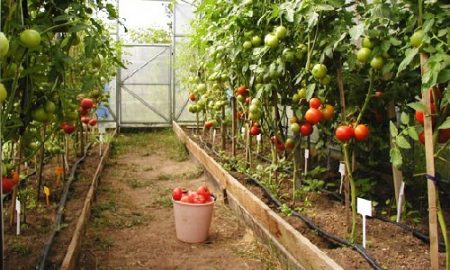 Any experienced gardener will tell you - you need to start working with tomatoes from the very beginning, that is, from seeds. If you prepare them correctly, half the battle has already been done for a good harvest. And then you need to find out what diseases of tomatoes are in the greenhouse, see their photos, and find out the treatment, then, knowing the enemy thoroughly, you can effectively deal with him.
Any experienced gardener will tell you - you need to start working with tomatoes from the very beginning, that is, from seeds. If you prepare them correctly, half the battle has already been done for a good harvest. And then you need to find out what diseases of tomatoes are in the greenhouse, see their photos, and find out the treatment, then, knowing the enemy thoroughly, you can effectively deal with him.
Take a look: marvelous tomatoes from russian gardens reviews.
Seed preparation
In the fight against future diseases, this is the trump card, because properly prepared seeds are more resistant, and it will be easier to grow plants.
- Sort the seeds, choose the strongest, smoothest and most accurate. (You can fill it with salt water, those that come up, empty dummies, throw them away, and leave heavy and high-quality ones lowered to the bottom).
- To process with potassium permanganate. Dilute potassium permanganate so that the solution turns out dark as a ripe cherry, and place the seeds in it for 15 minutes. You can use gauze for this, it will be more convenient, so as not to catch the seeds in solution, rinse. These manipulations will sanitize the seeds and enhance germination.
- Soak in ash solution. This nutrient mixture (there are a lot of minerals in wood ash) will saturate the seeds with useful substances, and they will be even stronger. Just add 0.5 liters of ash to half a liter of water, mix, and for ten hours put seeds there (you can also in gauze).
- Remove, transfer to clean warm water for another day.
- Harden the seeds, after washing, put on a saucer in the refrigerator for two days. Spray with water as it dries. All seeds are ready for planting. Now they will be less susceptible to disease, and it will be easier for you to take care of them.
Leaf mold
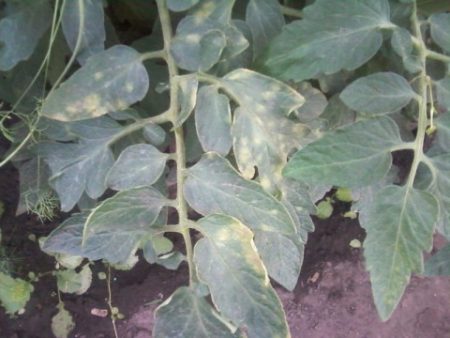
In polycarbonate greenhouses, tomatoes are often attacked by leaf mold. Brown spots appear on the back of the leaves, then they become covered with a somewhat grayish coating, the leaves dry out, the plant may die.
How to treat: Urgently reduce humidity in the greenhouse and reduce watering. Preventive measures - treat seedlings with copper chloride or Oxychoma solution, use the "Barrier", disinfect the greenhouse after harvesting with copper sulfate.
You might be interested in: planting cucumbers in 5 liter bottles.
Phytophthora
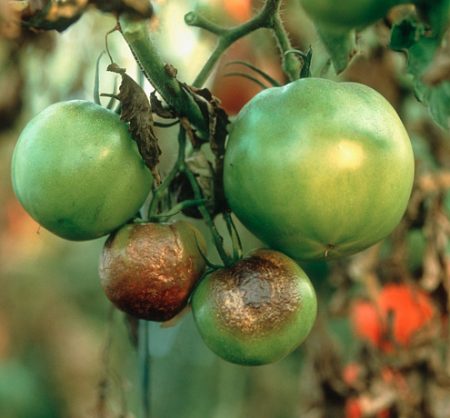
Yes, this nasty common disease does not pardon the greenhouse inhabitants, and it can damage the entire crop.
Signs: brown spots began to appear on the stems and leaves, if you look under the leaf - you see a whitish coating from mushroom spores, and brown spots appear on the fruits.
How to treat: the main thing in the fight against late blight is timely prevention. After transplanting the seedlings for three weeks, treat it with “Barrier”, another three - with “Barrier”, during flowering with garlic infusion - and your tomatoes will not catch this dangerous disease.
Macrosporiosis
This disease is also called dry spotting, it is characterized by the appearance of a round shape of brown spots, the death of leaves and a black velvet coating.
Treatment: like late blight.
Gray rot
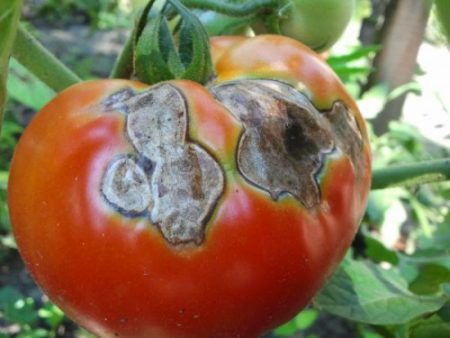
When damp, cold weather sets in, the fruits of the tomatoes can be affected by gray rot. Rounded spots appear on the tomatoes, emitting brown liquid, then the stems and leaves are covered with grayish mold.
Control measures: infected individuals are removed, the remaining plants are sprayed with “Fundazole” or “Barrier”.
Vertex rot
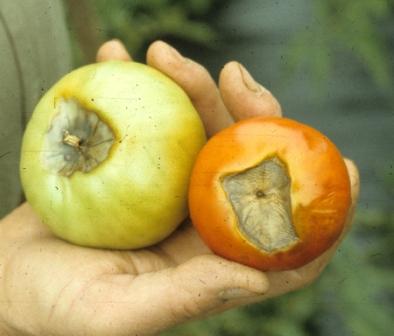
If on still green tomatoes you saw pressed spots exuding a putrid odor - this is vertex rot, which could have arisen due to an excess of nitrogen in the soil, a lack of calcium and moisture.
How to treat: destroy the affected fruits, treat the bushes with calcium nitrate at the rate of 1 spoon per bucket of ten-liter water.
Brown rot (phomosis)
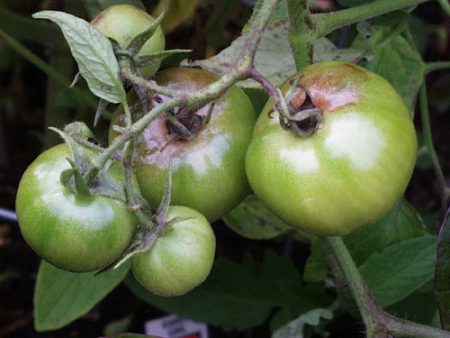
A stain appears at the base of the fruit, green tomatoes fall off.
How to treat: disinfect the soil, remove the affected fruit, reduce humidity in the greenhouse, and exclude manure.
Mosaic
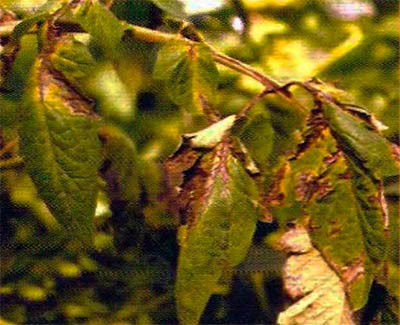
The disease is dangerous, it can destroy the crop in the greenhouse, caused by viruses. The leaves lose their shape, change color, spots appear green-yellow, wrinkled and curled leaves, bushes can come to dry.
Prevention and control measures: seed dressing in potassium permanganate helps, watering seedlings with manganese solution - every 18-20 days three times a day, or skim milk with urea (10 l of water / 1 l of milk / 1 tsp of urea).
Root rot
Since the root neck rotts with this sore, the bushes begin to fade.
How to fight: the sick layer of soil is replaced with a new one, the soil is disinfected with copper sulfate, treatment with the “Screen”.
Tomato Pests
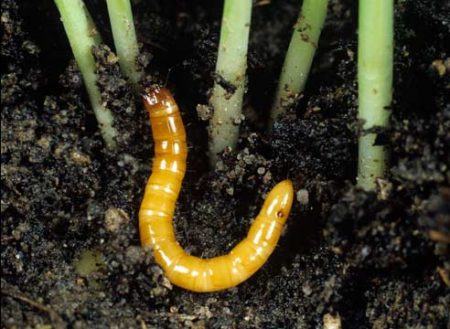
Wireworm Tomatoes, as well as plants planted under the open sky, can also disturb the greenhouse. Yellow caterpillars damage the stems and roots of plants.
How to fight: an interesting folk way - the remains of vegetables are strung on sticks and buried in the ground, leaving the tips of the sticks sticking out above the surface. A wireworm crawls on vegetables. Then the stick is pulled out together with the wireworm after a few days and burned. Liming the soil also helps.
Whitefly - A frequent guest in greenhouses, sucks juices from leaves. Afraid of Fosbetsid and Tsitkor, the drug "Arrow". For prevention, remove weeds.
Interesting information: Tomathouse.com for seniors.




 Low-growing tomatoes, without pinching: 5 of the most delicious varieties
Low-growing tomatoes, without pinching: 5 of the most delicious varieties Why tomato seedlings grow poorly
Why tomato seedlings grow poorly We grow a tomato in a shell
We grow a tomato in a shell Growing tomatoes without watering according to the method of Kazarin
Growing tomatoes without watering according to the method of Kazarin
Olga
For several years in a row I could not harvest a good tomato crop, every year the crop was affected by late blight disease. The early harvest of the tomato (not ripened - green) did not even help, the tomatoes still blackened!
This year, before planting, she cultivated the earth with a potassium permanganate solution. During the growth period, she tried to get rid of excess vegetation, removed side stepsons and excess foliage near the fruits.
I tried to water the tomatoes abundantly, but no more than twice a week.
During the flowering period, I treated all tomato bushes with the drug Fitosporin-M. This drug is inexpensive but effective! The harvest was exceptional !!!
Maria
This year there were terrible tomatoes, everything was almost gone, only the kids, who themselves, the seedlings, came up from last year, they survived. I’ll try, at your advice, to process with potassium permanganate and process phytosporin, perhaps to help.
Nadya
When I put a 6-meter greenhouse at home, I planted all of it with tomatoes, but now I cut plantings every year, now I plant only a third of tomatoes, and everything else is occupied by cucumbers, peppers, watermelons and melons - and it's all in one greenhouse, even without partitions and everything grows remarkably and the tomatoes do not even get sick. There is always a lot of tomato, I make from them a sweetener and tomato paste, and salt is very small special grade. Varieties always plant different in one place, even cherry tomatoes grow abundantly, but I plant them only a few bushes. So the greenhouse is a great thing that you won’t be left without a crop.